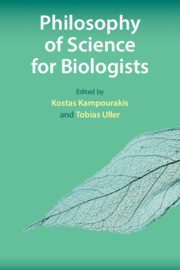Book contents
- Philosophy of Science for Biologists
- Philosophy of Science for Biologists
- Copyright page
- Contents
- Contributors
- Preface
- 1 Why Should Biologists Care about the Philosophy of Science?
- 2 What Constitutes an Explanation in Biology?
- 3 What Is Biological Knowledge?
- 4 What Is the Nature of Theories and Models in Biology?
- 5 How Are Biology Concepts Used and Transformed?
- 6 Why Does It Matter That Many Biology Concepts Are Metaphors?
- 7 How Do Concepts Contribute to Scientific Advancement?
- 8 How Can Conceptual Analysis Contribute to Scientific Practice?
- 9 What Methods Do Life Scientists Use?
- 10 Is It Possible to Scientifically Reconstruct the History of Life on Earth?
- 11 What Is the Basis of Biological Classification?
- 12 What Is the Nature of Scientific Controversies in the Biological Sciences?
- 13 What Is the Relation between Facts and Values in Biological Science?
- 14 A Philosopher in the Age of Creationism
- 15 How Can We Teach Philosophy of Science to Biologists?
- Further Reading
- Index
- References
9 - What Methods Do Life Scientists Use?
A Brief History with Philosophical Implications
Published online by Cambridge University Press: 04 September 2020
- Philosophy of Science for Biologists
- Philosophy of Science for Biologists
- Copyright page
- Contents
- Contributors
- Preface
- 1 Why Should Biologists Care about the Philosophy of Science?
- 2 What Constitutes an Explanation in Biology?
- 3 What Is Biological Knowledge?
- 4 What Is the Nature of Theories and Models in Biology?
- 5 How Are Biology Concepts Used and Transformed?
- 6 Why Does It Matter That Many Biology Concepts Are Metaphors?
- 7 How Do Concepts Contribute to Scientific Advancement?
- 8 How Can Conceptual Analysis Contribute to Scientific Practice?
- 9 What Methods Do Life Scientists Use?
- 10 Is It Possible to Scientifically Reconstruct the History of Life on Earth?
- 11 What Is the Basis of Biological Classification?
- 12 What Is the Nature of Scientific Controversies in the Biological Sciences?
- 13 What Is the Relation between Facts and Values in Biological Science?
- 14 A Philosopher in the Age of Creationism
- 15 How Can We Teach Philosophy of Science to Biologists?
- Further Reading
- Index
- References
Summary
This chapter is about the methods used in the life sciences. In it, I present a case that there are a limited number of methods that life scientists employ. On its face, this conclusion seems neither exciting nor novel; that is, unless we consider that the life sciences have long been engaged in a hidden battle between two opposing views regarding the number of scientific methods that exist. I am arguing against both sides. The two standard positions that I am arguing against are: (1) that there exists a single, if idealized, Scientific Method (i.e., unity), and (2) that the sciences are individualistic and, therefore, scientists operate without a common method (i.e., anarchy). I am asserting that in contrast to unity or anarchy, there are several but a limited number of methods possible in the bio-sciences. By combining general methods and submethods, there could be more than a dozen possible valid means by which to conduct a life sciences inquiry. I offer a table sketching out these methods and submethods at the conclusion of the chapter. But before I launch into explaining these two standard views and why a middle way, endorsing several but a limited number of methods, seems preferable, I want to begin with an example of modern life science in vivo, as it were.
- Type
- Chapter
- Information
- Philosophy of Science for Biologists , pp. 168 - 192Publisher: Cambridge University PressPrint publication year: 2020



